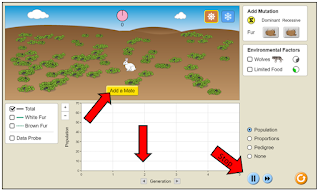I like to use online simulations but found it difficult to explain to my distance learning students what I wanted them to do. I also wanted to check their understanding. I made these steps for students to follow:
Go to: Phet Natural Selection Simulation Link
Click Intro
Use these settings:
Click Add a Mate
Look at the chart at the bottom. Click the stop button at 2 Generations.
1. What happens to the # of rabbits after 2 generations (at the current settings)?
A. # of rabbits increases
B. # of rabbits decreases
C. # of rabbits stays the same
Click the reset button
Change the settings – choose Limited Food
Click Add a Mate
Click the stop button after 2 Generations
2. Compare your # of rabbits after 2 generations (at the current settings) to your 1st simulation. What happened to the number of rabbits when food was limited?
A. # of rabbits increased
B. # of rabbits decreased
C. # of rabbits stays the same
Click the reset button
Change the settings – choose Wolves
Click Add a Mate
Click the stop button after 2 Generations
3. Compare your # of rabbits after 2 generations (at the current settings) to your 1st simulation. What happened to the number of rabbits when predators were added?
A. # of rabbits increased
B. # of rabbits decreased
C. # of rabbits stays the same
Click the reset button
Change the settings – choose a different season (Winter)
Click Add a Mate
Click the stop button after 2 Generations
4. Compare your # of
rabbits after 2 generations (at the current settings) to your 1st
simulation. What happened to the number
of rabbits when the climate is changed?
A. # of rabbits increased
B. # of rabbits decreased
C. # of rabbits stays the same
Click the reset button
Change the settings – choose a Dominant (brown fur)
Click Add a Mate
Click the stop button after 3 Generations and add Wolves
5. Compare the # of white and brown furred rabbits. Which ones were eaten by wolves most often?
6. TRUE or FALSE Limiting factors are sometimes helpful because they can keep the population from getting too large.
7. If there is more food than usual in an ecosystem, then...
A. Populations will stay the sameB. Populations will decrease
C. Populations will increase
8. If a disease destroyed the plants rabbits eat, what would
happen to the population?
B. The rabbit population would infinitely increase
C. The rabbit population would decrease
C. The biotic factors in the ecosystem would increase
D. The wolves predators would decrease
10. In a meadow ecosystem, which of the following is the best example of a limiting factor for a rabbit population?
A. Turtle PopulationB. SunlightC. Grass available












